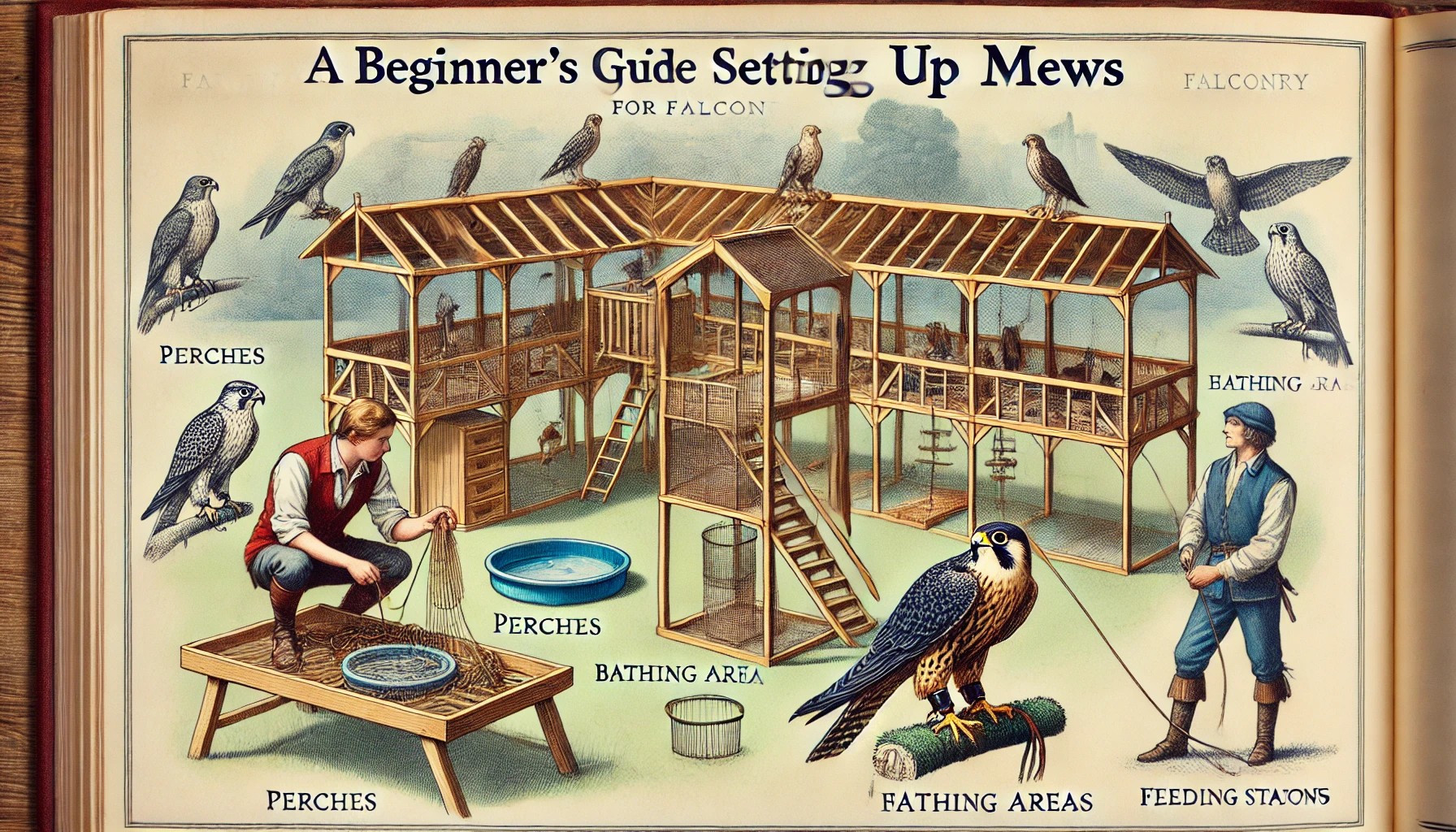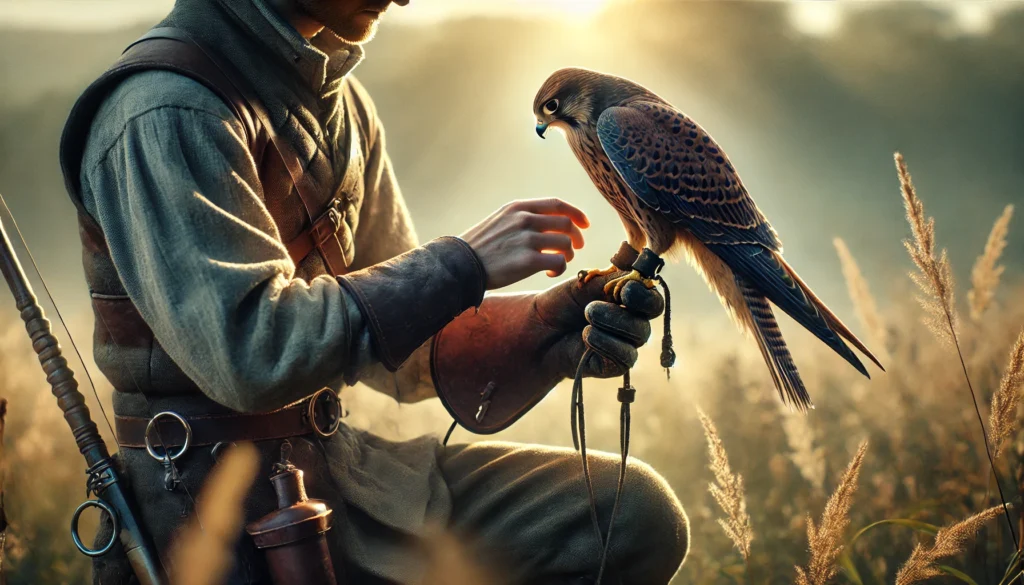Beginner’s Guide to Setting Up Mews
- Understand the purpose of a mew: It’s a secure place to house your bird where it feels safe and comfortable.
- Choose a good location: The mew should be in a quiet area with minimal disturbances to keep the bird calm.
- Ensure proper size: The mew should be spacious enough for the bird to spread its wings and move around without difficulty.
- Provide perches: Include perches of different sizes and materials to keep your bird’s feet healthy.
- Ensure good ventilation: Fresh air flow is essential to keep the bird healthy and reduce the risk of respiratory problems.
- Maintain cleanliness: Regularly clean the mew to avoid the buildup of waste and prevent disease.
- Install a secure door: The door should lock securely to ensure the bird cannot escape and to keep predators out.
- Add enrichment items: Toys and other engagement items will keep your bird mentally stimulated and happy.
- Ensure appropriate lighting: Natural light is best, but you can also use full-spectrum lighting to mimic natural conditions.
- Monitor temperature: Keep the mew in a temperature range that is comfortable and safe for your bird.
By following these guidelines, you can create a perfect mew for your bird, ensuring its well-being and happiness.
Setting Up Mews for Beginners: Your Falcon’s Irish Cottage
Welcome, future falconers! Have you ever dreamt about what it takes to home your magnificent raptor? Imagine an Irish cottage perched on a lush hillside ‘ it’s cozy, safe, and built just right to keep its inhabitants happy. This is exactly what you’ll be doing when setting up mews for your falcons!
In this article, we’re going to delve into the essential steps and tips for creating the perfect mews for beginners. Just like that cozy Irish cottage, your mews will be the sanctuary where your feathered friend feels comfy and secure. Whether you’re new to the falconry world or just need a refresher, this guide is tailored to help you every wing beat of the way.
Keep reading, as we’re about to share why the setup of your falcon’s home is crucial, touching on everything from space requirements to safety features. By the end, you’ll be equipped to give your falcon the best start possible. So, grab a cup of tea and get ready to transform that vision into reality!
Setting Up Beginner Mews: A Complete Guide to Falcon Housing Setup
Welcome to the exciting world of falconry! If you’re just starting out, setting up your beginner mews is one of the first steps you’ll take. But what is a mews in falconry? Simply put, a mews is the designated housing for your falcon. It’s like a safe and comfy bedroom for your bird. Setting up your falcon’s home correctly is super important because it helps keep your bird happy and healthy.
Choosing the Right Location
The first important decision in your falcon housing setup is picking the perfect spot for the mews. You’ll need an area that is quiet and away from too much human activity. This helps your falcon feel secure. It’s also a good idea to place the mews in a location where it can get some natural sunlight, but you should avoid placing it where it might get too hot or too cold.
Designing the Mews
When designing your beginner falconry housing, consider the size and layout. Your mews should be spacious enough for your falcon to spread its wings comfortably and move around a bit. At a minimum, the enclosure should be tall and wide to allow the bird to perch and fly short distances.
Tip: Learn more about different types of enclosures in our Falconry Equipment section.
Essential Elements Inside the Mews
- Perches: Perches are like furniture for your falcon’s home. They need to be comfortable and stable. Soft perches prevent foot injuries, ensuring your bird remains healthy.
- Bathing Area: Falcons need a place to bathe, as it helps keep their feathers in good condition. A simple shallow basin with fresh water works perfectly.
- Ventilation: Good airflow is critical in a beginner mews to keep the air fresh and prevent harmful bacteria from building up.
Securing the Mews
Your mews should be secure to protect your falcon from predators and escape. Strong, durable materials like wire mesh or heavy-duty wood are recommended. Also, check for any gaps or weak spots in the structure that a clever bird might find.
Additional Comforts and Safety Measures
In addition to the basics, adding some creature comforts can make the mews a lovely home for your falcon. Toys and enrichment activities can keep your falcon entertained and stimulated.
Tip: For more information on caring for your falcon, visit our Falcon Health and Nutrition page.
Legal Requirements
Before you finish setting up your mews, remember to review local and federal laws regarding falcon housing setup. Compliance ensures that you’re meeting all legal standards, which can prevent any future issues.
Tip: Check out our section on Legal Aspects of Falconry for detailed information.
Ongoing Maintenance
Maintaining your beginner falconry housing involves regular cleaning and inspections to ensure your falcon’s environment remains safe and healthy. Removing old food, cleaning perches, and providing fresh water daily are crucial tasks.
Getting Assistance
If you’re unsure about how to get started, consider joining a falconry club. Experienced falconers can provide valuable guidance and support.
Tip: For beginners, we recommend our Falconry for Beginners section to find more tips and mentors.
In setting up your beginner mews, remember that a well-prepared and comfortable home is the foundation for successful and happy falconry. Happy flying!
Beginner Guide to Setting Up Falconry Mews
If you’re new to falconry, setting up mews (indoor housing for your bird) can seem overwhelming. But don’t worry! By following some basic guidelines, you can create a safe and comfortable space for your feathered friend.
Minimum Indoor Facility Requirements
First, let’s discuss the must-have features for your indoor mews:
Size:
- Interior dimensions should be at least 8 feet in each direction. This space ensures your bird has enough room to spread its wings and move comfortably.
Safety:
- Interior surfaces must be smooth, with no beams or ledges that could harm your bird.
Ventilation and Light:
- At least one window with vertical bars or rods for sunlight and natural ventilation is essential.
Accessibility:
- A door for easy access and cleaning is crucial. The door should be key-locked and have a spring or hook to keep it closed and secure.
Flooring:
- The floor should be easy to clean and well-drained to maintain hygiene.
Perch and Water:
- Provide a suitable perch where the raptor can grip safely.
- Always have a pan of clean water available for your bird.
Outdoor Facilities
The outdoor area, or weathering yard, is equally important:
Space:
- Ensure there is enough space for your tethered raptor to exercise without striking its wings on the sides or top. A weathering area of at least 8′ x 8′ is a good starting point.
Protection:
- Enclose the sides and top with a sturdy material to keep predators out and your bird safe.
Environmental Protection
Maintaining a healthful environment is essential for the well-being of your raptors:
Temperature Control:
- Keep the facilities within a comfortable temperature range to prevent any health issues.
Weather Shielding:
- Ensure there is appropriate shelter to shield your bird from high winds and winter storms.
Predator Security:
- Protect your raptors from both avian and ground predators.
Noise and Disturbance:
- Minimize disturbances to prevent your bird from getting startled or injured.
Tips for Beginners
Having a few extra tricks up your sleeve can make setting up mews easier:
Spare Room:
- If possible, dedicate a spare room to your bird. This can make it simpler to maintain a clean and safe environment.
Wait and Learn:
- Consider waiting until you have the right setup and living conditions before beginning your apprenticeship in falconry.
Gaining Experience:
- Volunteering at a wildlife rehabilitation center or nature center can provide hands-on experience and valuable knowledge before you get your own bird.
By adhering to these guidelines, you can ensure that your mews meets the basic requirements for your raptor’s safety and comfort.
Important Statistics and Data on Falconry Mews Setup
To better understand the standards and best practices for setting up mews, let’s look at some data.
| Requirement | Description |
|---|---|
| Size | Minimum 8 ft x 8 ft in each direction |
| Windows | At least one window with vertical bars/rods |
| Flooring | Easy to clean and well-drained |
| Perch | Safe grip and stability for the bird |
| Clean Water | One pan per raptor |
| Outdoor Space | Minimum 8 ft x 8 ft weathering area |
| Temperature | Healthful temperature range |
| Protection | Shielding from wind, storms, and predators |
By following these specifications and tips, you will be well on your way to creating a suitable mews for your raptor. Falconry is a rewarding journey, and it all begins with setting up the right home for your bird.
Key Takeaways for Setting Up Mews for Beginners
Setting up a mews for your raptors is a crucial step in beginning your falconry journey. Ensuring that your indoor facilities meet the necessary requirements will help keep your birds safe and healthy. Remember that a well-built mews should have:
- Adequate Space: Mews should have dimensions of at least 8 feet in each direction, giving the birds plenty of room to move.
- Safe Interior: Ensure there are no beams, ledges, or protrusions that could harm the birds.
- Proper Ventilation: Include at least one window with vertical bars or rods for sunlight and ventilation.
- Easy Access: A key-locked door with a spring or hook is essential for easy access and cleaning.
- Clean and Safe Flooring: The floor should be easy to clean and well-drained.
- Comfortable Perches: Provide a perch that allows the birds to grip and hold safely.
- Clean Water: Ensure each raptor has a pan of clean water.
Don’t forget that your raptors also require outdoor facilities that provide enough space and protection from predators. By following these guidelines, you can create a safe, comfortable, and appropriate environment for your birds and begin your falconry journey on the right foot. Happy flying!



